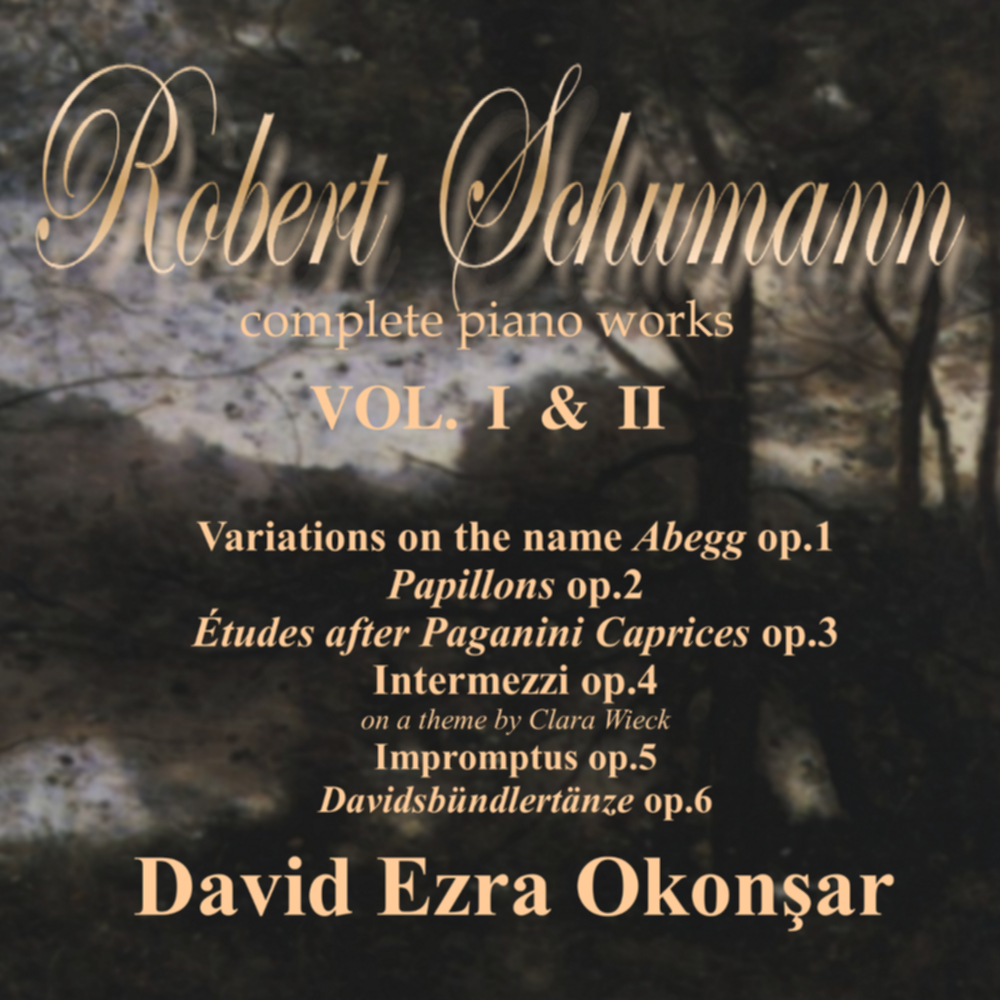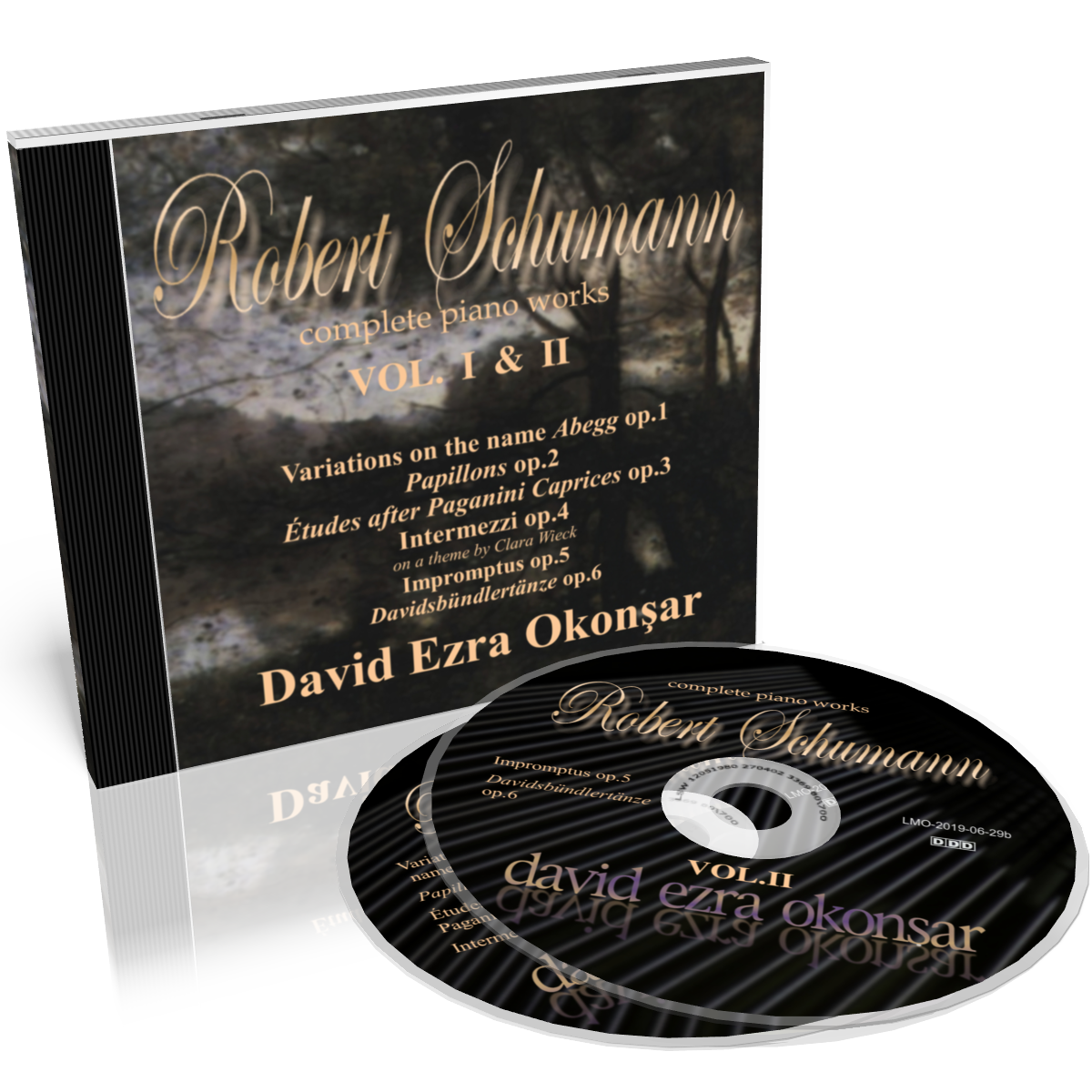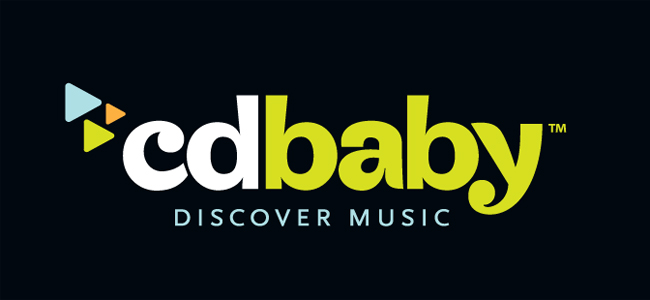

|
Robert Schumann
(1810-1856) Complete Works For The Piano
Early Years, Opus 1-6 (1830-37) From Abegg Variations op.1 to Davidsbündlertänze op. 6 Two CD Set Robert Schumann is the archetype of the romantic artist. He is the poet of the notes. It is impossible to understand his musical works without connecting them with literary sources as the composer conceived them. Unlike Chopin where music is an end by itself, with Schumann, music is the true expression of poetry. One may say for instance Kreisleriana, the Novelettes and the Carnaval or the Humorésque are all interpretations of the poetry by mostly E.T.A. Hoffmann and others. Ernst Theodor Amadeus Hoffmann (commonly abbreviated as E. T. A. Hoffmann; born Ernst Theodor Wilhelm Hoffmann (1776-1822) was a German Romantic author of fantasy and Gothic horror, a jurist, composer, music critic, draftsman and caricaturist. His stories form the basis of Jacques Offenbach's famous opera The Tales of Hoffmann, in which Hoffmann appears (heavily fictionalized) as the hero. He is also the author of the novella The Nutcracker and the Mouse King, on which Pyotr Ilyich Tchaikovsky's ballet The Nutcracker is based. The ballet Coppélia is based on two other stories that Hoffmann wrote, and Schumann's Kreisleriana is based on Hoffmann's character Johannes Kreisler. Hoffmann's stories highly influenced 19th-century literature, and he is one of the major authors of the Romantic movement. [from wikipedia.org] The Piano Works by Schumann can be divided into three or four periods. First from opus 1 to 28 and 32. This 10 years period is exclusively devoted two works for the piano. The second part of his career, up to 1845, which a period off deep crisis, shows a more diversified output. Starting from 1848 again we have more works for the piano. After that, the piano will be, again, his confident for the last works. Dense polyphonic textures are always present in Schumann's piano works. For Schumann, the counterpoint was always a spontaneous process. Shortly after a somewhat saloon-like style in the Variations Abegg (op.1) and Papillons (op.2) comes a time of high virtuosity. Following that, the composer gets involved in the large forms: Sonatas and Symphonies. For all composers following the Beethoven idea, large musical form became an obsession. Robert Schumann is no exception with large sonatas and with the Fantasie opus 17 Starting from 1837 his musical output runs at full throttle. This is when he will compose Davidsbündlertänze and the Phantasiestücke. Those are still successions of lyrical short pieces, but unlike Papillons or the Carnaval, here we have large structured cycles. It was such a prolific time of his entire life that he will later use some parts and pages from those times in Bunte Blatter op.99 and Albumblatter op.124. It is also amazing to note that the pianistic écriture of Schumann is more orchestral and his orchestrations are very much pianistic. Variations on the name "Abegg", op.1 (1830) The official opus one of Robert Schumann, the variations are from 1830. Schumann was just twenty at the time. Abegg was the surname of a girl, Meta Abegg, which he met in a ballroom at Mannheim. Schumann was always fascinated with names (letters) and musical notes correspondence as it appears in the German spelling of notes. Starting from A (a), in German language B stands for B-flat, H for B natural. The correspondence of the name BACH to music notes: B(-flat); A; C and H (B natural) is a well known example. So he built up his theme for those variations on the letters-notes ABEGG. To make believe he was in some relation with an important lady he did dedicate the work to some imaginary countess Pauline von Abegg. The theme expands as an ascending sequence of those letters (ABEGG) followed by its retrograde: G-G-E-B-A. Mostly in the style of light saloon-music, the work is not unlike Hummel's or Moscheles' light virtuosity and charming pieces. There is, nevertheless, some very personal touches. The syncopated lines of the second variation and some modulations at the Finale are very personal to Schumann. Papillons, op.2 (1829-1831) Even though Papillons were composed mostly in 1830, the original drafts trace back to 1829 and even earlier. Their overall organization precedes the official opus one: Variations Abegg. Basic musical material of Papillons can be traced back to earlier waltzes and polonaises for four hands that remained unpublished. There is so much Schubert in it that Schumann teased people by claiming that the number eight of Papillons was actually an unknown, unpublished piece by Schubert. Nevertheless, the literary sources of this work are far more important than the musical allusions to the music by Schubert. Actually "Papillons" is a turning point in the work of Schumann but also in the musical history as well. For never before literature was transposed to music with such acuteness. Flegeljähre ("awkward age") a well-known novel (1804 - 1805) by Jean Paul (Richter) that Schumann admired is the main source of inspiration. Jean Paul (born Johann Paul Friedrich Richter, 1763 - 1825) was a German Romantic writer, best known for his humorous novels and stories. Jean Paul occupies an unusual position in German literature and has always divided the readers in two camps. Some hold him in the highest veneration while others treat his work with indifference. Jean Paul habitually played with a multitude of droll and bizarre ideas: his work is characterized by wild metaphors as well as by digressive and partly labyrinthine plots. Three main characters in Flegeljähre are: Walt, the author's alter-ego, his opposite: Wult and Wina, the loved girl. Walt and Wult are already some prefiguration of Florestan and Eusébius. An early appearance of the bi-polar character in Schumann's personality. The choice of Jean Paul's novel exhibits that already, Schumann as a young man of twenty is unsure about the path to follow in his life: poetry or music? The final scene of Flegeljähre presents a fantastic and unreal masked ball where brothers Walt and Wult deliberately switch masks to create confusion. Understanding of this scene is of vital importance to Papillons. Opus two is made of twelve short pieces opened by a very short introduction. After the "raising of the curtain" (Introduzione) begins a short waltz, which will be later quoted in the sixth piece "Florestan" of Carnaval (opus 9, 1835). Here, Walt enters the vibrating and crowded ballroom (piece number one). There appears briefly the first "papillon", Wult, in a rush (Prestissimo, piece number two). But, besides Wult appears a grotesque vision: a lone boot wandering by itself, that is piece number three sort of one grotesque canon with octaves at both hands. The following piece, number four, represents masks. There are plenty of them: the "hope" (the mask of Wult); a shepherdess; a little nun; one harlequin... Next number (five) in B-flat major is a more extensive piece and represents Wina. This is followed by another kind of waltz. number six, and Schumann said that it was the crucial moment where Walt and Wult switched the masks. Sliding from F minor to A-flat major, number seven is where Wult confesses to Walt his love for Wina. Yet, Walt is the one to win the favors of Wina, in number eight, he brushed past the back of Wina like a wing of a butterfly (papillon). Various waltzes follow each other in numbers nine to eleven. Time to conclude: the Finale (number twelve), is mainly built with the popular German tune Grossvater-tänz, (grandfather-dance) and its ironic reply together with a vanishing reappearance of the first waltz, heard in number one, which disappears progressively. Grossvater-tänz is a curious old German family-dance of the 17th century, which was greatly in vogue at weddings. It consisted of three parts, the first of which was an Andante in triple time, sung to the words: "Und als der Grossvater die Grossmutter nahm, Da war der Grossvater ein Bräutigam" "And when the grandfather took the grandmother, Then the grandfather was a groom" to which succeeded two quick phrases in 2/4 time. As this dance usually concluded an evening, it was also called the 'Kehraus' (clear-out). So Schumann paraphrased it at the Finale of Papillons. The critics acclaimed this new work and the inventiveness of the young composer. op.3 Études after Paganini Caprices (1832) Schumann devoted himself for many years to his double vocation of pianist and composer. He soon realized that Abegg and Papillons were just starters and he needed to learn much more. He intensively studied new compositional techniques and even with the Intermezzi opus 4, from 1832 he engaged on a more elaborated musical path. For all artists of the time, Berlioz and Liszt included, Nicolo Paganini represented the ultimate in artistic virtuosity. Schumann did listen to Paganini in 1830. He was so much impressed that he composed his studies opus 3 and later on opus 10 titled Études d'après des Caprices de Paganini. He qualified "herculean works" those twelve pieces and experimented with them many pianistic possibilities. With those experiments he could embark on his new piano works with a much extended background. The two volumes after Paganini are from 1832 and 1833, so Schumann preceded Liszt whose Paganini Études however are better known. Even though Liszt's Études are far more showy and spectacular than Schumann's, they are aimed differently. Schumann himself, clarified the comparison by saying that Liszt did compose Études for the bravura where himself aimed to reveal the poetic content of the original music by Paganini. Liszt wanted to create by extrapolation, new pianistic possibilities from the violonistic effects of the Italian virtuoso; Schumann, on the other side, wanted to expand the latent harmonic content of the pieces. He relates in one letter that deciphering the latent harmonies in the Caprices for violin solo has been for him a challenge on music theory, also emphasizing that the instrumental technique was for him indistinguishable from musical content. He seemed quite happy with the results because he goes on: "even if I speak about an "adopted child", I "raised" him with diligence and great care". The two series (opus 3 and opus 10) are actually quite different from each other. The titles show the subtle distinction in the approach. Opus 3 is named: "Études d'après des caprices de Paganini" (Studies after the Caprices by Paganini) while opus 10 is titled: "Six Études de concert composées d'après des Caprices de Paganini" (Six Concert Studies Composed after the Caprices by Paganini). As the subtle wording of the titles suggests, the second set is less following the violin virtuoso composer's music literally and is more personal to Schumann. Schumann related that he was admiring the "audacity and the grandeur of the ideas" as well as the enthusiastic and unleashed vision" of Paganini. Two of the Caprices treated by Schumann were also handled by Liszt: the N.9 in E major in Paganini is the op.3 N.2 in Schumann and "La chasse" N.5 in Liszt; Caprice N.6 in G minor by Paganini is the N.2 of the opus 10 by Schumann and N.1 in Liszt. It is interesting to note that for this last number, in the first publication of the series by Liszt (dedicated to Clara Schumann), the Hungarian composer added the entire version by Schumann as an added musical staff at the top of his own music, as if hinting for a comparison... From the pianistic point of view, comparison between the opus 10 of Schumann and Liszt's version, if appropriate, can only favor Liszt. op.4 Intermezzi (1832) At 22, this can be seen as the first masterpiece of the composer. This compilation certainly deserves to be played more often. The form "intermezzo" will be extensively used later on by Brahms. Here, Schumann uses it for relatively developed pieces all in a ternary for with a contrasting middle section that he strangely calls "alternativo", may be for "Trio" as in scherzos. The Intermezzos, which will be soon followed by the Impromptus on a theme of Clara Wieck, op.5, are in the middle of this important period of the grand-virtuosity cycle by Schumann. Probably, the most important element by which this composition is a unique step in the composer's evolution is the rhythm and how he handles it. Here Schumann masters the use of all the key elements in this field he will be using all his life: a very personal use of the syncopations; dotted values; the ostinatos; the polyrhythms; two different beats in two hands etc. Those elements combine with an unprecedented harmonic audacity. This rather "new" language is the vehicle for expressing the "musical-poet"s sensitivity in full. Schumann was considering this work as one of his best and mentioned that in this particular work he confined himself to a "severe style", probably referring to the extensive use of the polyphony. op.5 Impromptus [on a theme by Clara Wieck] (1833) Here again is one of the least known pieces of the composer, and nothing justifies this abandon. The Impromptus op.5 are the outcome of the happy summer of 1833, where Schumann worked with Friedrich Wieck and fall in love with his fourteen years old daughter Clara. All three characters are in this interesting work. The opus 5 is dedicated to Friedrich Wieck for his birthday in August 1833, it is a series of Variations on a theme by Clara which are based on a bass-line given by Robert who received in return, a series of brilliant variations that the young girl composed on his theme! The name "impromptus" is a kind of hommage to Schubert but the work is a series of variations just in the middle point between the Variations Abegg and Études Symphoniques op.13. Schumann worked exhaustively on Bach during that time. He wrote: "during all that time I cultivated Bach. In this ambiance the Impromptus opus 5 were born". At the end however, he was not that satisfied with it and later on, for a second publication in 1850, he re-wrote important parts of it. op.6 Davidsbündlertänze (1837) (The Dance of David's Comrades) On the third of April 1834 was issued the first number of the Neue Zeitschrift für Musik (New Musical Journal) founded by Schumann. The composer himself was the author of most of the articles in it. He used three pen-names according to the mood of the writing. "Florestan": man of action, dashing, passionate, bold and daring, somehow chivalrous; "Eusébius": the depressive, tender and sentimental dreamer and a wise mediator: "Maître Raro" who was incarnating in some aspects his to be father-in-law: Friedrich Wieck at least before the furious opposition of the piano teacher to the marriage of his daughter with the young composer did not alter definitely their relations. Right from the beginning of the gazette, Schumann added a tribe of characters, more or less imaginary even though most of them are based on real persons. One of those are the Comrades of David, unified in their strong opposition with the Philistines of the Art. Schumann himself took the part of David. The comrades of David were meeting at Kaffebaum, a Leipzig tavern they renamed for the circumstances: Ludlamshöhle after the name of the cave Adullam. The Cave of Adullam was originally a stronghold referred to in the Old Testament, near the town of Adullam, where future King David sought refuge from King Saul. Mendelssohn and the young Wagner were among the first contributors to the Neue Zeitschrift für Musik. However, on theory, according to Schumann the "brotherhood" included Beethoven, Mozart, Schubert, Chopin, Berlioz as opposed to the Philistines: Rossini, Herz, Meyerbeer, Czerny, Pleyel, Thalberg among others. That included the conformist and reactionary critique and the bourgeois public hostile to anything new in music. The Davidsbündlertänze, one of the greatest compositions of Schumann was born in 1837, while he was fervently hoping to conquer Clara's love and hand in marriage and pursuing his activism for the new music. A work of struggle for modernism, freedom, new ideas in harmony, tonality, rhythm and musical form, the opus six is almost a manifesto. The first publication, two volumes with nine numbers each, in 1838 was not mentioning any composer's name, it was just titled: "Pièces caractéristiques composées par Florestan et Eusébius" (Characteristic Pieces Composed by Florestan and Eusébius). Schumann apposed his initials at the end of each piece. In 1850, the second publication was issued, he removed his initials as well as the ending "-tänze" who, nevertheless, remained in the common usage, it is true that most pieces do have dancing-like aspects. Besides the surprising flexibility of the harmony and tonality one shall mention the overall organizing of the cycle which is far from being disparate. Pieces one to five are orbiting around G major, B minor and its relative D major. By simply changing the mode to D minor, the sixth piece leads us in the flat-key regions. The journey into the flat-keys include G minor, E-flat major, C minor, [C major] and D minor. The listener remains in the flats up to the number ten. Again by switching modes from D minor to D major we are back in the sharp-keys, at number 11 we stay in the sharp-keys up to number 13. A last and sudden switch from B major to E-flat major enharmonically dives into flat keys with the number 15 included. Last two numbers and the epilogue return to the keys of the beginning: G major, B minor and D major. The epilogue, in C major, is a flash back to the entire cycle. |
|||||||||||
|
|
|||||||||||
|






